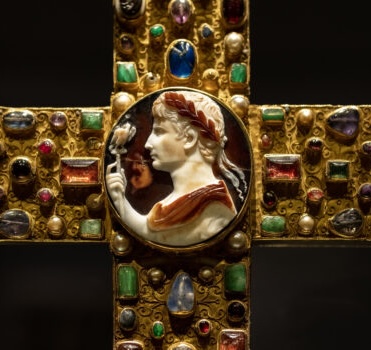The most exciting treasure in the lavish Treasury of Aachen’s Cathedral is certainly the so-called Cross of Lothair. In the treasury museum, the Ottonian processional cross is most peculiarly displayed with the colorful principle side facing the wall (a nod to how the cross was oriented when carried into the church or more modern Germanic perversity?) but do not be deterred, as there is plenty of room to walk around the case for a gander.


Set at the very center of the sumptuous surround is a massive sardonyx cameo of the emperor Augustus (detail in second photo), a work of exceptional quality and importance that had circulated in royal and ecclesiastical treasuries for some thousand years before being installed in this sacred Christian object. All around is a wildly colorful grab-bag of gumdrop-like cabochons and less distinguished ancient intaglios, some plopped sideways and upside-down. The orientation of these ancient gems was beside the point, with the color and antique allure the evident draw.
The extent to which Otto III (the emperor for whom the cross was made) recognized Augustus as the first Roman emperor is somewhat up for debate (it could be a delicious case of mistaken identity, along the lines of mistaking Augustus’ wanton daughter as the Virgin Mary or the Ptolemies Philadelphoi as the Three Magi). But combined with the large (if somewhat drab) rock-crystal seal belonging to Carolingian Lothair II installed in the bottom arm of the cross, I’m inclined to read the cameo’s inclusion as a savvy act of self-promotion on Otto’s part, placing himself and his dynasty within a great imperial trajectory.




